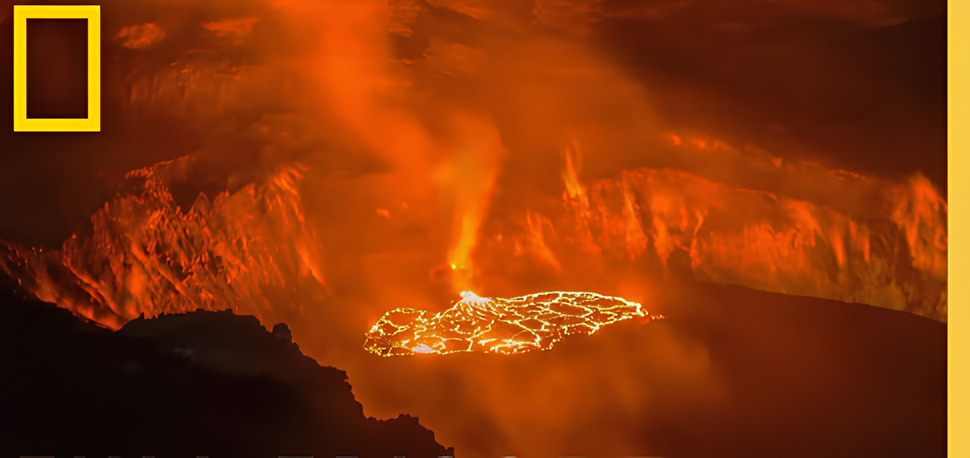Kilauea, one of the most active volcanoes on Earth, is a marvel of nature. Nestled on the Big Island of Hawaii, it offers a unique blend of awe-inspiring power and captivating beauty.
This shield volcano has been erupting continuously since 1983. Its effusive eruptions, rather than explosive, produce mesmerizing lava flows that shape the landscape.
Part of the Hawaii Volcanoes National Park, Kilauea is a UNESCO World Heritage Site. It’s not just a geological wonder, but also a cultural treasure, deeply significant to Native Hawaiians.
In this article, we’ll explore the wonders of Kilauea, its geological significance, historical eruptions, and the unique experiences it offers. Whether you’re a geology enthusiast, a potential visitor, or simply curious, join us on this fascinating journey.
The Majesty of Kilauea Volcano
Kilauea Volcano stands as a testament to Earth’s dynamic and ever-changing landscape. Its shield-like form, with gentle slopes, is typical of the volcanoes in Hawaii. This shape results from the fluid nature of its lava flows.
Kilauea’s summit caldera, known as Halema’uma’u, is a sight to behold. This vast crater has an active lava lake, drawing visitors with its fiery glow, especially at night.
One of the most captivating aspects of Kilauea is its lava flows. The sheer volume of molten rock that cascades down its slopes is a mesmerizing spectacle. These flows create new land upon reaching the ocean.
The East Rift Zone of the volcano is another area of constant activity. This region frequently experiences eruptions and seismic activity, showcasing the intense geological forces at work.
Kilauea’s eruptions have crafted a rich tapestry of landscapes. From barren lava fields to lush rainforests, the volcano’s influence on the surrounding environment is profound.
Standing near Kilauea, one feels a deep connection to Earth’s primal forces. It’s a humbling experience that invites reflection on our planet’s power and beauty.
Kilauea’s Geological Significance
Kilauea is one of Earth’s most active volcanoes, and its significance to geology is profound. As a shield volcano, its broad shape defines much of its character. This results from the low-viscosity lava that flows from its depths.
The volcano is part of the Hawaiian-Emperor seamount chain. This chain exemplifies hotspot volcanism, where magma rises as the Pacific Plate moves.
Kilauea’s regular eruptions provide critical insights into volcanic processes. Scientists study the movement of magma and the development of volcanic features.
Lava flows have continually shaped the Big Island’s landscape. These flows play a crucial role in how new land emerges from volcanic activity.
Studying Kilauea helps us understand the inner workings of our planet. Its continuous activity offers valuable information for both scientists and students of geology.
The Continuous Eruptions of Kilauea
Kilauea Volcano is known for its persistent activity. It has erupted almost continuously since 1983. This long streak has captured the attention of scientists and tourists alike.
The eruptions at Kilauea are usually effusive, meaning the lava gently flows. This contrasts with more explosive volcanoes, making Kilauea somewhat unique.
Lava from Kilauea often creates dramatic landscapes. It consistently reshapes the island, extending land as it reaches the sea. These new formations become part of Hawaii’s evolving topography.
Eruptions offer more than just a geological spectacle. They provide data that is invaluable to the study of volcanic activity. The volcano serves as a natural laboratory.
Kilauea’s continuous eruptions have deep cultural significance. Native Hawaiians link the volcano’s activity to Pele, the goddess of fire. This connection adds a spiritual layer to its geological importance.
Kilauea Military Camp: A Unique Stay
Kilauea Military Camp offers a distinctive lodging experience. Located inside Hawaii Volcanoes National Park, it caters to military personnel and their families. This setting allows visitors to stay close to an active volcano.
The camp provides a range of accommodations. Guests can choose from various cabins and cottages. These lodgings combine comfort with an unbeatable natural backdrop.
Beyond accommodation, the camp includes diverse facilities. Recreational options include a bowling alley, theater, and dining facilities. These amenities make it a lively hub of activity amid the natural surroundings.
Staying at Kilauea Military Camp presents unique opportunities. Visitors can explore hiking trails and scenic vistas nearby. The proximity to Kilauea enhances these outdoor adventures.
The camp’s position within the park ensures an immersive experience. Guests enjoy the blend of military history and volcanic wonder. This balance makes it a remarkable destination for a memorable visit.
Visiting the Hawaii Volcanoes National Park
Hawaii Volcanoes National Park offers a spectacular exploration venue. It’s home to Kilauea and Mauna Loa, two of the world’s most active volcanoes. This park is a UNESCO World Heritage Site, rich in natural beauty and cultural history.
Visitors can enjoy a variety of activities within the park. Trails wind through lush rainforests and barren lava fields. Each path offers a unique look into Kilauea’s dynamic landscape.
To make the most of a visit, consider the following experiences:
- Hike the Crater Rim Trail for spectacular views.
- Visit the Thomas A. Jaggar Museum to learn about volcanology.
- Explore the Thurston Lava Tube, a fascinating natural formation.
- Take a scenic drive along the Chain of Craters Road.
- Attend a ranger-led program to gain deeper insights into the park.
The park experience is exhilarating. The eruptive power of Kilauea is present everywhere. It highlights the vibrant, ever-changing environment of the Big Island.
Visiting this national park is an adventure for all ages. The blend of geology and history creates a memorable journey. It’s a place where nature’s raw power is on full display, inspiring awe and respect.
The Cultural Impact of Kilauea
Kilauea is much more than a geological wonder. It holds significant cultural value, deeply woven into Hawaiian mythology. Many Native Hawaiians view Kilauea as the home of Pele, the goddess of fire and volcanoes.
Pele is a central figure in many Hawaiian stories and legends. Her fiery nature embodies both creation and destruction. This duality is mirrored in the continual reshaping of the land by volcanic activity.
For the local communities, Kilauea influences daily life and traditions. Rituals and offerings to Pele are common practices among those who live nearby. These cultural practices show the deep respect locals have for the volcano’s power.
Furthermore, Kilauea’s presence inspires art, music, and dance. Many cultural expressions pay homage to its grandeur and spiritual significance. These artistic endeavors connect people to their history and environment.
This volcano’s cultural importance extends beyond Hawaiians. Its mythical and awe-inspiring nature draws global interest. People worldwide come to appreciate Kilauea’s unique blend of natural beauty and cultural heritage.
The 2018 Eruption and Its Aftermath
The 2018 eruption of Kilauea was a powerful event. It captured global attention with its intense activity. This eruption was one of the most destructive in recent history.
Lava flows inundated residential areas, causing evacuations. Many properties were destroyed, and communities were deeply affected. The eruption altered the landscape significantly.
Volcanic gas emissions were also a major concern. These emissions impacted air quality, posing health risks. Residents and visitors needed to take precautions.
The event reshaped the local economy. Tourism saw a decline at first due to safety concerns. However, interest in Kilauea surged once conditions stabilized.
This eruption highlighted the unpredictable nature of volcanoes. Scientists have used the data collected to improve monitoring techniques. The event provided valuable insights into volcanic behavior and response strategies.
Scientific Monitoring and Volcanology
Kilauea’s activity is closely monitored by scientists. The Hawaiian Volcano Observatory plays a crucial role in this effort. Advanced tools provide real-time data on volcanic changes.
Seismographs detect tremors and shifts in the earth. These instruments help predict potential eruptions. They are vital in assessing the volcano’s movements.
GPS technology tracks ground deformation. It provides insight into magma movement underground. This information is key for understanding eruption patterns.
Gas sensors measure volcanic emissions. These sensors monitor gases like sulfur dioxide. Changes in gas levels often indicate increasing volcanic activity.
Scientific research at Kilauea enhances global knowledge. Studies here improve volcanic hazard preparedness. The findings aid in developing better response plans.
Safety and Regulations for Visitors
Visitors to Kilauea are advised to follow safety guidelines. The dynamic nature of the volcano requires caution. Staying informed of current activity is crucial.
Park regulations help ensure visitor safety. Officials provide updates on restricted areas. These measures protect both tourists and natural habitats.
Avoid getting too close to active lava flows. The heat and fumes pose significant risks. Always heed posted warnings and advisories.
The Dynamic Ecosystems of Kilauea
Kilauea hosts a wide range of ecosystems. The varying altitudes and lava flows create diverse habitats. From lush rainforests to barren lava fields, the landscapes vary dramatically.
Many unique species thrive in Kilauea’s environment. Some plants and animals are found nowhere else on Earth. They have adapted to life near an active volcano.
These ecosystems change with each eruption. New land forms as lava cools. Over time, life returns, showcasing nature’s resilience and adaptability.
Educational Opportunities at Kilauea
Kilauea offers rich learning experiences for visitors. Educational programs help deepen understanding of volcanic activity. These programs are accessible to all ages.
Ranger-led tours take visitors through Kilauea’s unique features. These informative sessions cover the history and science of the volcano. Participants gain valuable insights into volcanic phenomena.
The Thomas A. Jaggar Museum enhances this educational journey. It provides exhibits on volcanology and geology. Visitors leave with a deeper appreciation for the dynamic forces at work.
Conclusion: The Living Legacy of Kilauea
Kilauea stands as a testament to Earth’s dynamic nature. Its eruptions continuously shape and reshape the landscape. This active volcano serves as a focal point for scientific study and tourism alike.
Beyond its geological impact, Kilauea influences Hawaiian culture deeply. The stories of Pele and the ongoing volcanic activity form a unique cultural tapestry. Such rich lore draws both researchers and curious travelers.
Kilauea offers more than just geological insights. It represents the coexistence of natural power and cultural heritage. As Kilauea continues to evolve, it reminds us of our planet’s vibrant and ever-changing character.


